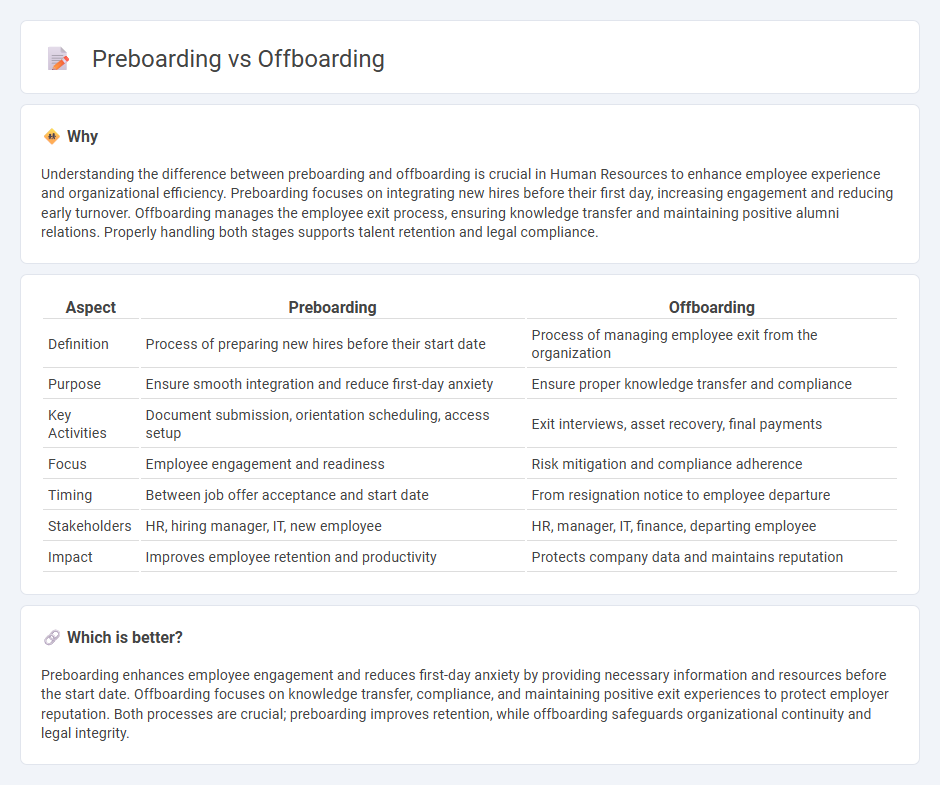
Effective human resources management involves seamless preboarding and offboarding processes to enhance employee experience and organizational efficiency. Preboarding prepares new hires with essential information and resources before their first day, while offboarding ensures a smooth transition for departing employees, safeguarding company knowledge and maintaining positive relations. Explore our comprehensive guide to optimize both preboarding and offboarding strategies.
Why it is important
Understanding the difference between preboarding and offboarding is crucial in Human Resources to enhance employee experience and organizational efficiency. Preboarding focuses on integrating new hires before their first day, increasing engagement and reducing early turnover. Offboarding manages the employee exit process, ensuring knowledge transfer and maintaining positive alumni relations. Properly handling both stages supports talent retention and legal compliance.
Comparison Table
| Aspect | Preboarding | Offboarding |
|---|---|---|
| Definition | Process of preparing new hires before their start date | Process of managing employee exit from the organization |
| Purpose | Ensure smooth integration and reduce first-day anxiety | Ensure proper knowledge transfer and compliance |
| Key Activities | Document submission, orientation scheduling, access setup | Exit interviews, asset recovery, final payments |
| Focus | Employee engagement and readiness | Risk mitigation and compliance adherence |
| Timing | Between job offer acceptance and start date | From resignation notice to employee departure |
| Stakeholders | HR, hiring manager, IT, new employee | HR, manager, IT, finance, departing employee |
| Impact | Improves employee retention and productivity | Protects company data and maintains reputation |
Which is better?
Preboarding enhances employee engagement and reduces first-day anxiety by providing necessary information and resources before the start date. Offboarding focuses on knowledge transfer, compliance, and maintaining positive exit experiences to protect employer reputation. Both processes are crucial; preboarding improves retention, while offboarding safeguards organizational continuity and legal integrity.
Connection
Preboarding and offboarding are integral components of the employee lifecycle, ensuring smooth transitions into and out of an organization. Effective preboarding enhances new hire engagement and productivity, while strategic offboarding preserves knowledge and maintains positive employer reputation. Both processes rely on clear communication, comprehensive documentation, and aligned HR policies to optimize workforce management and retention.
Key Terms
**Offboarding:**
Offboarding is the structured process that manages an employee's exit from a company, covering tasks such as knowledge transfer, exit interviews, revoking access to systems, and ensuring compliance with legal requirements. Effective offboarding minimizes operational disruption, protects company data, and fosters positive alumni relationships that can benefit future business opportunities. Discover more about optimizing offboarding strategies for enhanced organizational resilience and employee experience.
Exit Interview
Exit interviews are crucial during offboarding to gather insights on employee experience, reasons for departure, and potential organizational improvements. Preboarding, occurring before the official start, aims to enhance new hire engagement but does not involve exit interviews. Explore how integrating structured exit interviews can transform your offboarding process.
Knowledge Transfer
Offboarding emphasizes systematic knowledge transfer to ensure critical information and expertise are retained within the organization before an employee departs. Preboarding focuses on initial knowledge sharing to prepare new hires with essential company insights and role-specific information, facilitating quicker integration and productivity. Explore strategic knowledge transfer techniques to optimize both offboarding and preboarding processes.
Source and External Links
Employee Offboarding - This process involves the structured transfer of an employee's responsibilities and knowledge when they leave a company, ensuring minimal disruption and maintaining company security.
Offboarding Best Practices & Steps - A well-executed offboarding program minimizes disruptions, protects confidential information, and gathers feedback from departing employees.
Offboarding - This HR process separates an employee from their employer, focusing on maintaining positive relations, ensuring security, and transferring knowledge.
 dowidth.com
dowidth.com